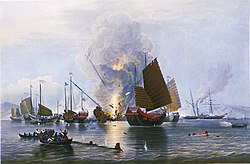 Drawing of the Starling, 1835 | |
| History | |
|---|---|
| Name | HMS Starling |
| Namesake | Starling |
| Ordered | 8 December 1828 |
| Builder | Pembroke Dockyard |
| Laid down | June 1829 |
| Launched | 31 September 1829 |
| Reclassified | Converted to survey ship, 1834 |
| Fate | Sold, February 1844 |
| General characteristics | |
| Class & type | Lark-class cutter |
| Tons burthen | 107 73⁄94 tons bm |
| Length | |
| Beam | 20 ft 3 in (6.2 m) |
| Depth of hold | 9 ft (2.7 m) |
| Sail plan | Schooner rig |
| Complement | 34 |
| Armament |
|

HMS Starling was a 4-gun schooner of the British Royal Navy, one of the two ships in an expedition led by Edward Belcher to survey the Pacific coast of the Americas. [1] Henry Kellett was captain of the ship in the First Opium War with China. [2]